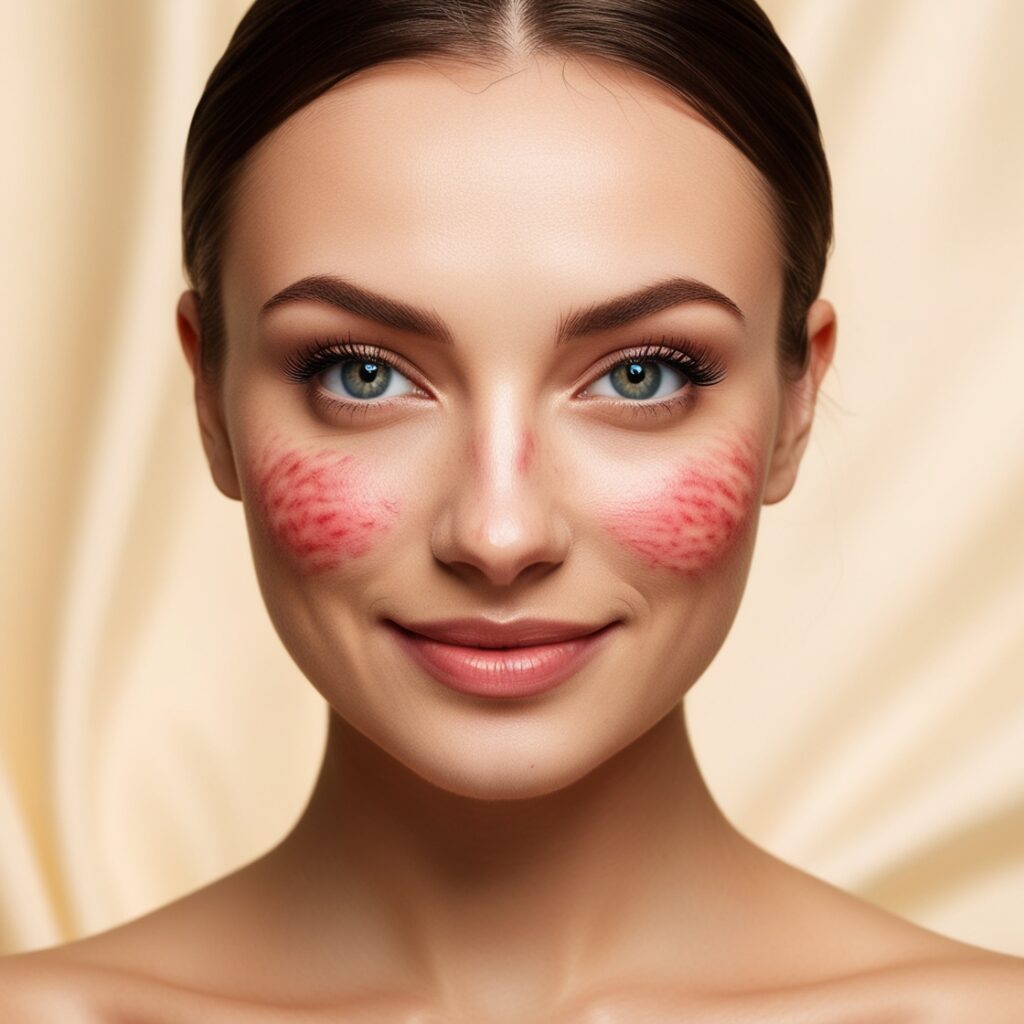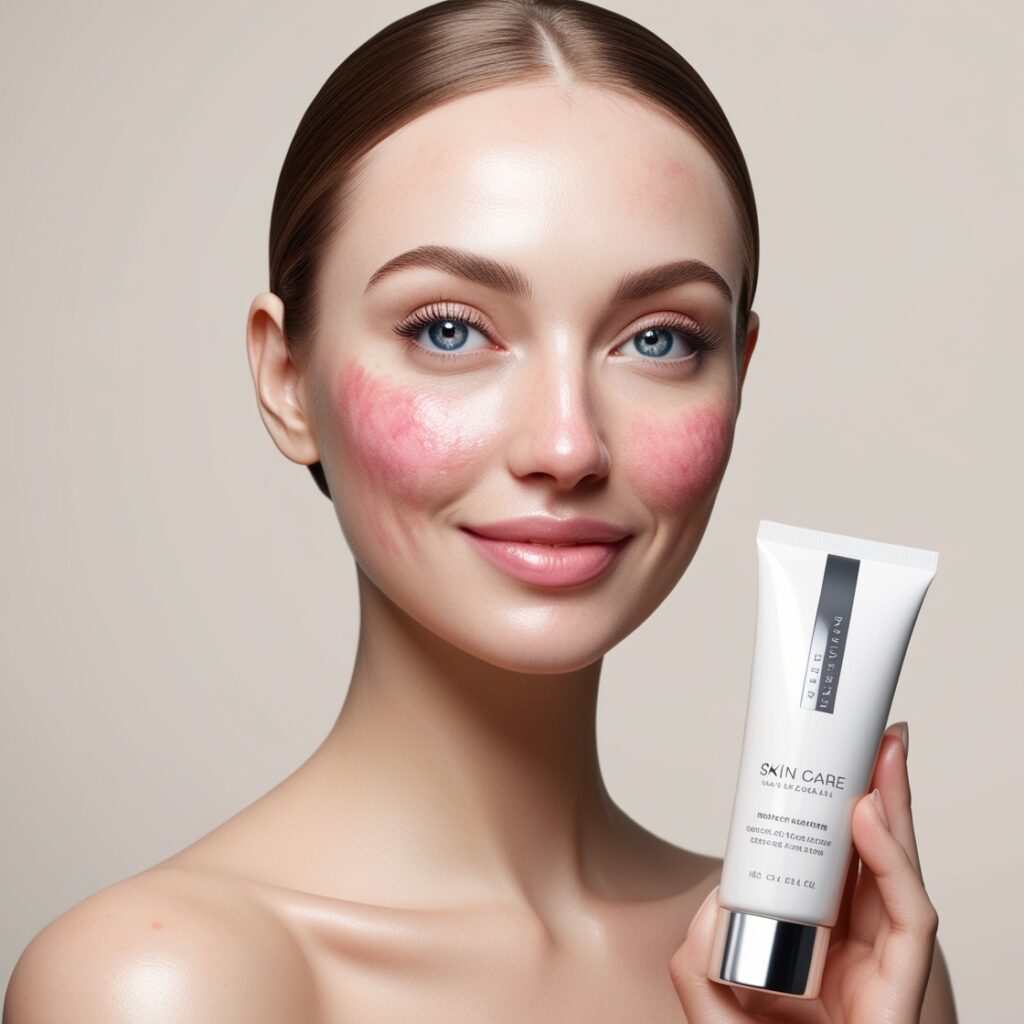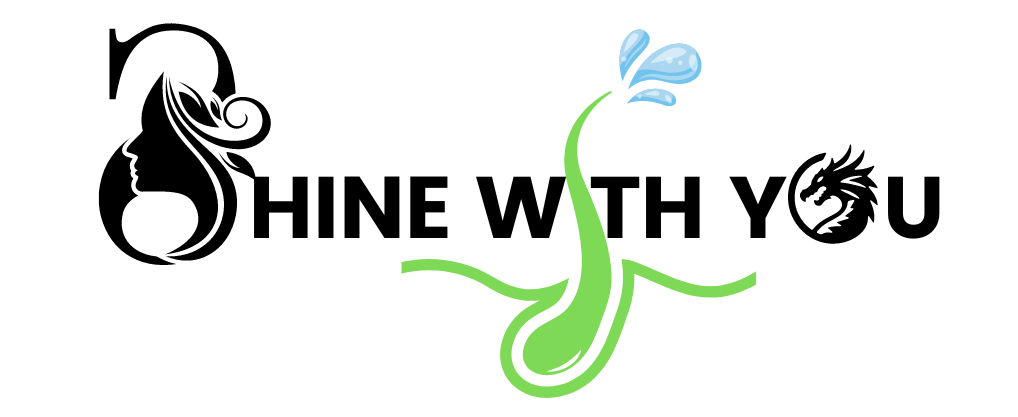What is Rosacea?
Rosacea is a chronic skin condition primarily affecting the face, characterized by redness, visible blood vessels, and sometimes acne-like breakouts. Although anyone can develop rosacea, it’s more common among fair-skinned individuals and often appears after the age of 30. Its cause isn’t fully understood, but it’s thought to involve a combination of genetic, immune, and environmental factors. It tends to be cyclical, with flare-ups and remissions. While rosacea is not life-threatening, but as a result it can affect one’s quality of life due to appearance and associated discomfort.

Symptoms of Rosacea
1. Facial Redness:
Facial redness, or erythema, is one of the most common and noticeable symptoms of rosacea. It often begins as a tendency to flush or blush easily, but over time, this redness can become more persistent and spread across the nose, cheeks, chin, and forehead. The redness occurs due to the dilation of blood vessels near the surface of the skin, which makes them more visible. In some cases, the blood vessels can become permanently enlarged, leading to a condition called telangiectasia, where tiny red lines (often referred to as spider veins) are visible on the face.
2. Visible Blood Vessels:
Visible blood vessels, known as telangiectasia, are a common symptom of rosacea, appearing as fine red or purple lines on the face, especially around the nose and cheeks. These vessels become visible due to repeated dilation and constriction caused by triggers, which over time can damage the vessel walls. As the vessels enlarge, they become more noticeable on the skin’s surface and may even appear permanently.
3. Swollen Bumps Or Pimples In Rosacea :
Swollen bumps or pimples, medically termed as papules and pustules, are common symptoms of a subtype of rosacea known as papulopustular rosacea. These red, inflamed bumps can resemble acne, leading to confusion with typical acne breakouts. However, unlike acne, rosacea pimples don’t typically contain blackheads and are concentrated on the central face, including the cheeks, nose, chin, and forehead.
4. Eye Irritation :
Eye irritation, also known as ocular rosacea, is a common but often overlooked symptom that affects the eyes. It can cause discomfort, dryness, redness, and a sensation of grittiness, as though there is sand or a foreign object in the eye. The eyelids may also become swollen or develop small bumps, and in some cases, the eyes can appear bloodshot. If left untreated, ocular rosacea may lead to more serious issues, including blurry vision and, in severe cases, corneal damage.
5. Thickened Skin:
Thickened skin, known as phymatous rosacea, is a less common but significant symptom. This condition is characterized by the gradual thickening of the skin, which can result in a bumpy texture, most often affecting the nose (a condition called rhinophyma), but it may also occur on the chin, forehead, cheeks, or ears. The skin may appear enlarged, rough, and more oily, with visible pores. In advanced cases, this thickening can alter the shape of facial features, particularly the nose, giving it a bulbous appearance.
6. Burning or Stinging Sensations:
Burning or stinging sensations are common symptoms in rosacea, especially during flare-ups. These sensations often accompany redness and can create significant discomfort, causing the skin to feel hot, tender, or sensitive to touch. Many people with rosacea report that certain areas of the face, like the cheeks, nose, or chin, experience these symptoms more intensely, and they can worsen after exposure to certain triggers.
Causes of Rosacea
The exact cause of rosacea is not known, but several factors are believed to play a role:
1. Genetics:
While the exact cause of rosacea is not fully understood, genetics play a significant role in predisposing certain individuals to the condition. Studies suggest that it often runs in families, indicating a hereditary component. People with a family history of rosacea are more likely to develop it themselves, especially those with fair skin and Northern European ancestry, though the condition can affect any skin type.
2. Immune System:
An overactive immune system is thought to be a major factor in the development of rosacea. Research suggests that people with rosacea may have an immune system that overreacts to certain triggers, leading to chronic inflammation and the hallmark symptoms of the condition, such as facial redness, visible blood vessels, and acne-like bumps.
One specific protein, cathelicidin, is believed to play a role in this immune response. In healthy skin, cathelicidin helps defend against infection. However, in people with rosacea, the body may produce higher levels of abnormal cathelicidin peptides, which promote excessive inflammation, causing redness, swelling, and irritation. Another potential factor involves antimicrobial peptides (AMPs), molecules that fight bacteria and infections but can also trigger inflammatory responses when they’re dysregulated, as they seem to be in rosacea.
3. Demodex Mites:
Demodex mites are microscopic parasites that naturally inhabit human skin, particularly in areas with a high concentration of sebaceous (oil) glands, such as the face. Two species are commonly found on humans: Demodex folliculorum and Demodex brevis. While these mites are typically harmless and exist in small numbers, research has suggested a potential link between an overpopulation of Demodex mites and the development of rosacea.
4. Bacteria (H. pylori):
Helicobacter pylori (H. pylori) is a type of bacteria primarily known for its association with gastrointestinal conditions, particularly peptic ulcers and chronic gastritis. Recent studies have suggested a potential link between H. pylori infection and rosacea, although the exact relationship is still being explored.
Triggers of Rosacea
Flare-ups can be triggered by a variety of factors. Common triggers include:
1. Sun Exposure:
Sun exposure is one of the most common and significant triggers for rosacea flare-ups. For many individuals with this condition, even brief exposure to sunlight can lead to increased redness, swelling, and the development of acne-like bumps. The ultraviolet (UV) rays from the sun can cause inflammation and damage to the skin, exacerbating the symptoms of rosacea.
2. Hot or Cold Weather:
Extreme temperatures, whether hot or cold, are well-known triggers for rosacea flare-ups. Individuals with rosacea often have skin that is more sensitive to changes in temperature, leading to increased redness, irritation, and discomfort during various weather conditions.
3. Stress as a Trigger for Rosacea:
Stress is a well-documented trigger for flare-ups of this skin condition, affecting many individuals with it. The connection between stress and the condition is multifaceted, as emotional stress can lead to physiological changes in the body that exacerbate skin symptoms.
4. Dietary Factors:
Dietary factors can significantly influence the severity and frequency of rosacea flare-ups. While specific triggers may vary from person to person, several common foods and beverages have been associated with increased symptoms in many individuals with rosacea. The most common frequent dietary triggers are: spicy foods, hot drinks, alcohol and caffeine.
5. Physical Exertion:
Physical exertion, especially during intense exercise, can be a strong trigger for rosacea symptoms, leading to facial flushing, redness, and sometimes swelling. For many with rosacea, the increase in body temperature and blood flow from physical exertion can worsen symptoms, making it challenging to engage in exercise or strenuous activities without experiencing discomfort.
6. Medications:
Certain medications can trigger or worsen rosacea symptoms in some individuals. These medications may increase facial redness, cause blood vessels to dilate, or affect the immune system in ways that lead to flare-ups. Knowing which medications can exacerbate rosacea can help individuals manage their condition more effectively, often with guidance from a healthcare provider.
7. Skincare Products:
Certain skincare products can worsen rosacea symptoms, leading to increased redness, dryness, or irritation. People with this condition often have sensitive skin, so choosing the right skincare products is essential to avoid triggering flare-ups. Ingredients that cause irritation, overly harsh formulations, or products that disrupt the skin barrier are common culprits.

Treatment Options for Rosacea
While there is no cure for rosacea, several treatments can help manage its symptoms and reduce flare-ups.
1. Topical Medications:
- Metronidazole: Metronidazole is a commonly prescribed topical treatment for rosacea, valued for its anti-inflammatory and antibacterial properties. Available as a gel, cream, or lotion, metronidazole is an effective option for managing mild to moderate rosacea symptoms, particularly redness, inflammation, and papules (small bumps).
- Azelaic Acid: Azelaic acid is a popular topical treatment for rosacea, particularly for reducing redness, inflammation, and acne-like bumps (papules and pustules) associated with the condition. Available in gel or foam formulations, azelaic acid offers both anti-inflammatory and antibacterial properties, making it a versatile option for people with mild to moderate rosacea.
- Brimonidine: Brimonidine, commonly available as a topical gel under brand names like Mirvaso, is a prescription medication used to manage facial redness caused by rosacea. Brimonidine belongs to a class of drugs known as alpha-adrenergic agonists. By constricting blood vessels in the skin, it helps reduce visible redness and flushing, providing temporary relief from rosacea symptoms.
2. Oral Medications for Rosacea:
- Antibiotics: Oral antibiotics are a widely used treatment for moderate to severe rosacea, particularly when symptoms include inflammatory papules and pustules (acne-like bumps) and persistent redness. While antibiotics are not a cure for rosacea, they can help reduce inflammation and bacterial overgrowth, leading to a reduction in flare-ups and improved skin clarity. Oral antibiotics are typically prescribed for short-term use, often in combination with topical treatments to manage symptoms.
- Isotretinoin: Isotretinoin is a powerful oral retinoid often known for its effectiveness in treating severe acne, but it can also be used off-label to treat specific cases of rosacea, especially when other treatments haven’t been successful. Isotretinoin may be considered for cases of rosacea that involve persistent papules, pustules, and skin thickening, as well as for patients who experience severe inflammation that isn’t responsive to other medications.
3. Laser and Light Therapy For Rosacea:
Laser and light-based therapies are popular, effective options for managing rosacea symptoms, particularly for reducing redness, visible blood vessels, and thickened skin. These treatments target the underlying vascular problems associated with, helping improve skin appearance and reduce the frequency of flare-ups. While they do not cure rosacea, they can provide significant relief and improve skin texture.
4. Lifestyle and Skincare Adjustments:
- Gentle Skin Care: For individuals with this skin condition, a gentle skincare routine is essential. Affected skin is highly sensitive, and using products that are too harsh can lead to flare-ups, increased redness, and irritation. The goal of a gentle skincare routine is to reduce inflammation, maintain hydration, and protect the skin’s natural barrier.
- Sun Protection: Sun exposure is one of the most common triggers for flare-ups of this skin condition, making sun protection a crucial part of its management. UV rays not only exacerbate redness and inflammation but can also increase skin sensitivity and make affected skin more reactive. Therefore, daily use of sunscreen with SPF 30 or higher is essential.
- Avoid Triggers: Managing rosacea effectively often involves identifying and avoiding specific triggers that can cause flare-ups. Although its triggers vary from person to person, common ones include certain foods, environmental conditions, skin care products, and lifestyle factors. Avoiding or minimizing exposure to these triggers can significantly reduce symptoms and improve quality of life for those with rosacea.
5. Alternative Treatments:
- Green Tea Extract:Green tea extract is a popular natural ingredient for managing this skin condition due to its anti-inflammatory, antioxidant, and soothing properties. It contains compounds like polyphenols, especially epigallocatechin gallate (EGCG), that help reduce redness, irritation, and visible blood vessels associated with the condition.
- Niacinamide: Niacinamide, also known as vitamin B3, is a powerful ingredient with anti-inflammatory, antioxidant, and barrier-strengthening properties, making it particularly beneficial for people with rosacea. It can help reduce redness, calm inflammation, strengthen the skin barrier, and improve overall skin texture.
Living with Rosacea
Living with rosacea can be challenging due to the unpredictable nature of flare-ups and the visible impact on the skin. For many, it affects not only the skin but also their confidence and mental well-being. The good news is that with the right management strategies, It’s possible to reduce symptoms and feel more in control of the condition.
Identifying and avoiding personal triggers is a key part of managing this problem, which can vary from person to person. Common triggers include sun exposure, stress, spicy foods, alcohol, hot beverages, and extreme temperatures. Keeping a diary of food, skincare, and environmental factors can help pinpoint specific triggers, making it easier to avoid them in daily life.
Overall, Managing rosacea is often a matter of lifestyle adjustments and proactive skincare. Working with a dermatologist to develop a personalized treatment plan and identifying potential triggers can help reduce flare-ups and improve quality of life.
Join our community! Subscribe to receive updates on [shinewithyou.com]. Don’t forget to share your thoughts and ideas in the comments section below each post. Your feedback will motivate me to provide more new hair and skin care solutions, remedies, and tips Thank you.

1 thought on “Rosacea: Overview | Symptoms | Causes | Triggers & Treatments”